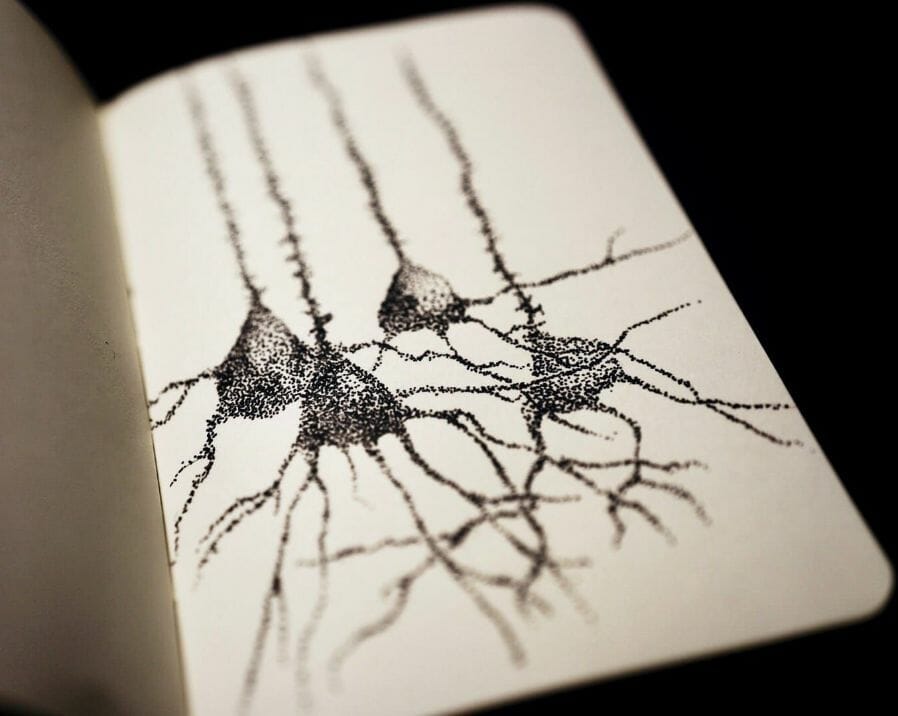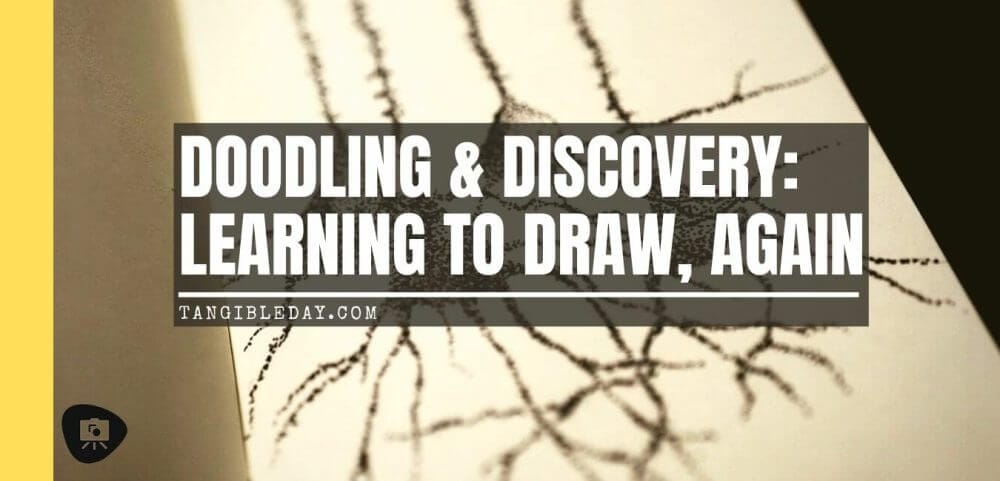I’ve been trying to teach myself how to draw again. But, I don’t want to just “draw” anymore like I did when I was younger. I want to express abstract concepts and ideas. Unlike writing poetry or stories (or blog posts), drawing and doodling images have the power to HIT YOU IN THE FACE. Okay, maybe putting words in all capital letters can also slap you.
I digress.
In this article, I present a few doodles that I did after many years of being away from the drawing media. As you read on, you’ll see why I came up with my 5 tips I recommend for the beginning doodler or drawer
5 Tips for Better Doodles and Drawings
Here are the 5 things I would recommend to someone who has the desire to doodle and draw better.
- Keep making marks
- Your tools are secondary
- Don’t be too serious
- Know your subject (even the random scribble has a purpose)
- Let the pen and ink (or whatever) do the talking
Doodling is Discovery

You might think this is a random doodle. But, in fact, this was my focused effort on trying to understand how comfortable I was using my fountain pen as a primary drawing tool.
More than that, I discovered that doodling was loosening up my creative juices. As I put marks on the paper, I felt more free to keep going.
It was as though doodling random bits on paper took the weight off me to be serious. Maybe, you and I being too serious is the problem.

I used a TWSBI Mini with a fine nib. The balance is perfect for my hands. I have used it mostly for writing notes at work. But, I have grown to enjoy this pen as a doodler.
The stainless steel nib glides across paper. This makes it great for free-associating ideas and … doodling.
Doodling is the warm-up for the great marathon.
The unwritten point of doodling is to discover, to add thrill to a blank page or period of time.
Not that I expect I have the endurance (or skill) to make great artistic works. Instead, I was trying to find out how much I wanted to draw and…simply mark up paper in unconventional ways.
I suppose doodling is a metaphor for life: keep making marks.
Fountain Pens on Thin Paper: Bad!
Well, I did discover that the fountain pen had a major limitation.
The fountain pen ink bleeds through my notebook paper.
Of course, I’m using my classic Moleskine notebooks, which are notoriously bad for wet-writing instruments. But, they are super awesome for gel pens.
So, I had two options:
- Use a different notebook with better paper
- Don’t doodle with a fountain pen
Given that I’d already spent some money on the fountain pen, I decided to be irrational. I went ahead and purchased a few technical pens from a local art store.
I went with a Copic Multiliner, which is a refillable pen. Even the felt-tipped nib is replaceable after it wears out. I only bought one pen, unsure if I’d like using it to draw. I went with a 0.25mm, which I think is the second smallest nib you can get.
It’s an amazing pen!
The black ink is DARK. I love contrast. It’s the key to making art stand out. T
This pen helps make things pop against white paper.
The Power of Dots (Stippling)

I messed around with simple shapes. Adding them together, seeing how they could create complex structure. After all, any structure you see is mainly different smaller parts put together.
One thing I remember from art class when I was taught to draw: “don’t stop a project until you’ve learned something.”
In this case, my goal was simply to draw a building. Any building. In this case, it was a castle-looking structure. Maybe a sand castle I saw in my head.
I added dots for sand.
Then, I realized that if you cluster the dots together, they would act as shading. I knew this already as “stippling” technique, but it was a light bulb moment. That, stippling could be used for adding texture as well as value (dark or light).
Ta-da! I had learned something. I could have stopped.
But, I kept going….

Just a little further along, I realized that my drawing needed context. This castle needs to be situated somewhere on the ground.

I added stippled mountains and hills. The Copic pen was perfect as it created these perfectly round dots (when held vertically).
Nice round dots. When I finished getting those blurry mountains dotted/stippled in, I stopped.
I called this castle: done.
I had learned about the power of dots.
Stippling is Life
One of my favorite subjects for photography or any visual art is the veritable branch-form. I am drawn to the fractal, the self-similar organic structures that make up so many things in nature and the human-made World.

Taking what I learned about stippling, I went ahead and started doodling nerve cells. These cells in the body that relay and process information through electrical impulse.
Of course, knowing nothing about drawing these things, I just free-associated myself through what my imagination thought they might look like.
Hint: I have some in-depth microscope experience looking at neurons on a fairly routine basis.
But, this particular drawing was a technical FAILURE. See below.

Taking a cue from my art classes of yesteryear, I tried shading my neurons with stippling. The Copic multiliner gave me a lot of control over dot creation. With some practice I was able to put dots very close together without overlapping them.
Making sure your stippling dots don’t overlap is key to a “smooth” looking shade.
Unnecessary Tools?
I watched a lot of YouTube videos on the practice of stippling. People do it differently, and the gamut of tools I’ve seen are endless. The one tool set I’d like to try one day is the dip pen (a modern version of the quill pen) and an ink bottle.
Unfortunately, after I finished my first stippled neuron, I got comments that told me I didn’t hit the target.
“Looks like cracks,” someone on Reddit said. “I love drawings of cracks.”
Obviously, this person was right. My neurons had the cracked-like structure of broken stone or concrete.
My cells didn’t look “organic” enough.
FAILURE!
Move on and keep drawing, I told myself.
A big part of drawing and doodling is learning how to communicate.
It’s a language. I still have to learn the vocabulary of drawing.
To practice a skill, you need to learn the language of that skill.
My stippling and rendering language for communicating the idea of “neuron” was incomplete.
And, so I keep practicing.
Your tools are secondary.
Just check out Peter Draws YouTube channel. He uses everything and anything to make art. And, he’s able to use any tools to draw because Peter has mastered the “language”.
I need to draw more and more!
Many Doodles and Drawings Later: Success?
I wanted to draw neurons. To convey the simple beauty of the nervous system in the body.
What I learned after many days of doodling and practicing is that I was wrong about a principle about my subject-matter.
Neurons are not random structures. They have a purpose.
Structure has a reason, which is to perform a function.
I took many hours of doodling and drawing to learn this:
Structure serves function.

For this next “drawing”, as practice, I tried to start with a pencil sketch first.
I know I didn’t want to use the pencil too much. I wanted to keep the fluidity and permanence of ink as the main driver of the drawing.
So, I lightly outlined where the main subjects would be located. Kind of like working out the composition of a photograph in the viewfinder of a camera.
Pressing a camera’s shutter would be equivalent of inking the sketch.
The joy of working with ink is the inability to go back. You have to learn-to-live with mistakes. Every mark counts and doesn’t at the same time.
Still don’t understand?
I think our minds work in a non-linear fashion when we create things. There is no start or end point, just a happy cloud of ideas.
When I put ink on paper, I imagine my mind is placed there, too. And so, I’m free to say that each mark is meant to be there.
Liberation is the experience of knowing you can’t make any mistake except “to do nothing”.
Keep making marks.
And, you’ll see a final product emerge.

How long does drawing with stippling take?
I think my latest drawing of a cluster of Pyramidal neurons is fairly successful.
I common question I have been asked about stippling is: “how long does it take to finish a drawing?”
This particular drawing took about 3 hours, including the pencil under sketch. It was created on a 3.5×6″ notebook with sketch quality paper. The subjects aren’t very large.
If did the calculation correctly, I made about 3 dots per second. Over the course of 2-3 hours, that means there are about 28,000 to 32,000 dots in this drawing of neurons.
I imagine I could do a better job if I had a larger canvas to work on. I was somewhat limited by the size of the dots I could make.
To add more resolution on a stippled drawing, I either have to get a smaller nib pen, or work larger.
The cool part about finished a “piece” is that I now have the desire to see if I can do better.
I want to do another drawing to find out what other things I can express without writing a single word.

Doodling the Organic Machine
In regards to writing, there are some subjects that can’t be described in less than a thousand words.
That’s where drawing and doodling come into play.

Keep looking maybe you’ll recognize something. I did, but only after I made it with ink and paper.
As a scientist, there are so many unknown things in our natural world.
What goes on inside the human body; inside the cells that control how we live and thrive?
I wonder, yet will never know all the answers despite the powerful tools at my disposal, e.g., microscopes, reagents, instruments of all shiny kinds.
So, maybe once in a while I’ll let my sleepless mind travel a bit down that road.
I’ll let the pen and ink do the talking.
Final Thoughts
I think young kids love to doodle and draw because we are born with the need to make stuff. To reflect that inner Creator in the world we live in.
Whether it’s with crayons or more sophisticated tools, doodling and drawing is an act of being human.
Animals don’t create art (controversial, I know).
But, I mean “art” as a way of communicated abstract or even concrete ideas: things like “love” or “neuron”, respectively.
At the end of the day, if you’re looking to doodle and draw more, and want to improve, keep these 5 things in mind:
- Keep making marks
- Your tools are secondary
- Don’t be too serious
- Know your subject (even the random scribble has a purpose)
- Let the pen and ink (or whatever) do the talking
I’ve taken up doodling and drawing as another way to communicate abstract ideas. More than this, I’m learning to draw and doodle to experience a kind of discovery that can experienced without electricity, or going outside of my kitchen, bedroom…bathroom?



Tangible Day on YouTube (Miniatures and More!)



Made me see doodling in a totally different way. I used to doodle while I am thinking and when I am stressed. Never really knew it can create such magnificent work. Something to try. Great post